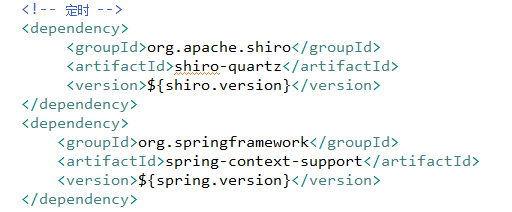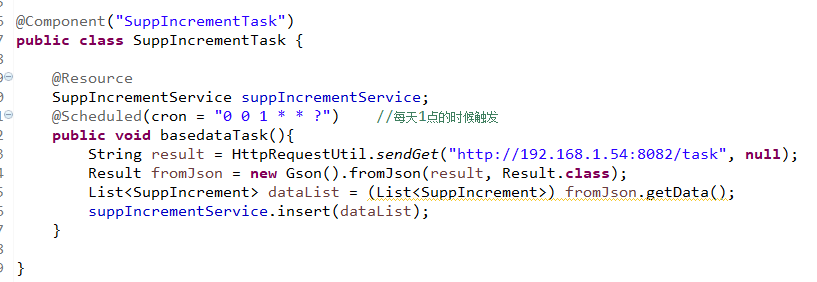第一步:添加jar包

第二步:在spring配置文件中添加
<context:annotation-config/>

第三步:编写定时代码

我们通常做Java后台接口,是让前端访问的,让前端获取数据或者做增删改查,但是有时候,我们做的Java接口是让其他系统的Java后台调用的,让其他系统从我们这个系统获取数据或者做业务
public class HttpRequestUtil {
/**
* 向指定URL发送GET方法的请求
*
* @param url
* 发送请求的URL
* @param param
* 请求参数,请求参数应该是 name1=value1&name2=value2 的形式。
* @return URL 所代表远程资源的响应结果
*/
public static String doPOST(String urlAddress, String params) {
try {
// 创建URL对象
URL url = new URL(urlAddress);
// 打开连接 获取连接对象
URLConnection connection = url.openConnection();
// 设置请求编码
connection.addRequestProperty("encoding", "utf8");
// 设置允许输入
connection.setDoInput(true);
// 设置允许输出
connection.setDoOutput(true);
// 从连接对象中获取输出字节流对象
OutputStream outputStream = connection.getOutputStream();
// 将输出的字节流对象包装成字符流写出对象
OutputStreamWriter outputStreamWriter = new OutputStreamWriter(outputStream);
// 创建一个输出缓冲区对象,将要输出的字符流写出对象传入
BufferedWriter bufferedWriter = new BufferedWriter(outputStreamWriter);
// 向输出缓冲区中写入请求参数
if(params != null){
bufferedWriter.write(params);
}
// 刷新输出缓冲区
bufferedWriter.flush();
// 从连接对象中获取输入字节流对象
InputStream inputStream = connection.getInputStream();
// 将输入字节流对象包装成输入字符流对象,并将字符编码为GBK格式
InputStreamReader inputStreamReader = new InputStreamReader(inputStream, "utf8");
// 创建一个输入缓冲区对象,将要输入的字符流对象传入
BufferedReader bufferedReader = new BufferedReader(inputStreamReader);
// 创建一个字符串对象,用来接收每次从输入缓冲区中读入的字符串
String line;
// 创建一个可变字符串对象,用来装载缓冲区对象的最终数据,使用字符串追加的方式,将响应的所有数据都保存在该对象中
StringBuilder stringBuilder = new StringBuilder();
// 使用循环逐行读取缓冲区的数据,每次循环读入一行字符串数据赋值给line字符串变量,直到读取的行为空时标识内容读取结束循环
while ((line = bufferedReader.readLine()) != null) {
// 将缓冲区读取到的数据追加到可变字符对象中
stringBuilder.append(line);
}
// 依次关闭打开的输入流
bufferedReader.close();
inputStreamReader.close();
inputStream.close();
// 依次关闭打开的输出流
bufferedWriter.close();
outputStreamWriter.close();
outputStream.close();
// 将可变字符串转换成String对象返回
return stringBuilder.toString();
} catch (IOException e) {
e.printStackTrace();
}
return null;
}
public static String sendGet(String url, String param) {
String result = "";
BufferedReader in = null;
try {
String urlNameString = url + "?" + param;
URL realUrl = new URL(urlNameString);
// 打开和URL之间的连接
URLConnection connection = realUrl.openConnection();
// 设置通用的请求属性
connection.setRequestProperty("accept", "*/*");
connection.setRequestProperty("connection", "Keep-Alive");
connection.setRequestProperty("user-agent",
"Mozilla/4.0 (compatible; MSIE 6.0; Windows NT 5.1;SV1)");
// 建立实际的连接
connection.connect();
// 获取所有响应头字段
Map<String, List<String>> map = connection.getHeaderFields();
// 遍历所有的响应头字段
/* for (String key : map.keySet()) {
System.out.println(key + "--->" + map.get(key));
}*/
// 定义 BufferedReader输入流来读取URL的响应
in = new BufferedReader(new InputStreamReader(
connection.getInputStream()));
String line;
while ((line = in.readLine()) != null) {
result += line;
}
} catch (Exception e) {
System.out.println("发送GET请求出现异常!" + e);
e.printStackTrace();
}
// 使用finally块来关闭输入流
finally {
try {
if (in != null) {
in.close();
}
} catch (Exception e2) {
e2.printStackTrace();
}
}
return result;
}
/**
* 向指定 URL 发送POST方法的请求
*
* @param url
* 发送请求的 URL
* @param param
* 请求参数,请求参数应该是 name1=value1&name2=value2 的形式。
* @return 所代表远程资源的响应结果
*/
public static String sendPost(String url, String param) {
PrintWriter out = null;
BufferedReader in = null;
String result = "";
try {
URL realUrl = new URL(url);
// 打开和URL之间的连接
URLConnection conn = realUrl.openConnection();
// 设置通用的请求属性
conn.setRequestProperty("accept", "*/*");
conn.setRequestProperty("connection", "Keep-Alive");
conn.setRequestProperty("user-agent",
"Mozilla/4.0 (compatible; MSIE 6.0; Windows NT 5.1;SV1)");
// 发送POST请求必须设置如下两行
conn.setDoOutput(true);
conn.setDoInput(true);
// 获取URLConnection对象对应的输出流
out = new PrintWriter(conn.getOutputStream());
// 发送请求参数
out.print(param);
// flush输出流的缓冲
out.flush();
// 定义BufferedReader输入流来读取URL的响应
in = new BufferedReader(
new InputStreamReader(conn.getInputStream()));
String line;
while ((line = in.readLine()) != null) {
result += line;
}
} catch (Exception e) {
System.out.println("发送 POST 请求出现异常!"+e);
e.printStackTrace();
}
//使用finally块来关闭输出流、输入流
finally{
try{
if(out!=null){
out.close();
}
if(in!=null){
in.close();
}
}
catch(IOException ex){
ex.printStackTrace();
}
}
return result;
}
}
}